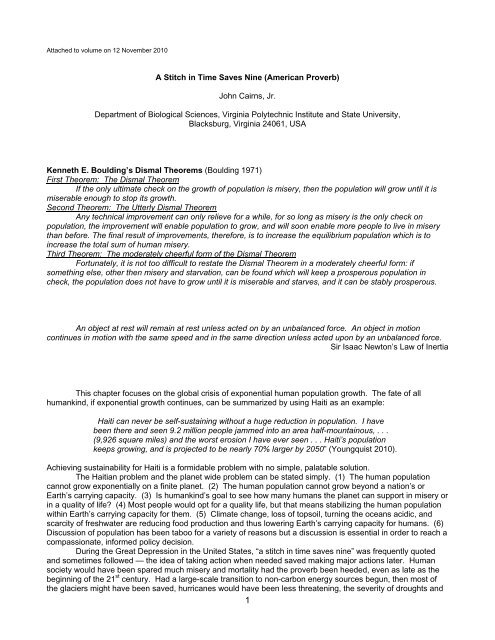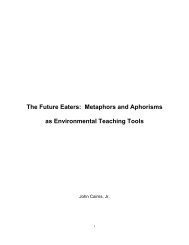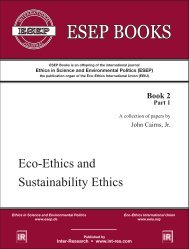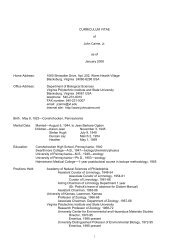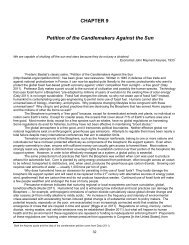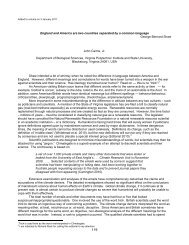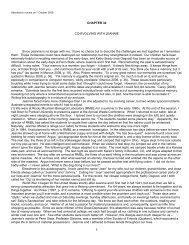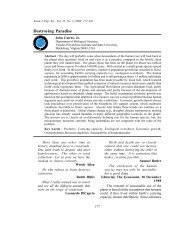A Stitch in Time Saves Nine (American Proverb) - Professor John ...
A Stitch in Time Saves Nine (American Proverb) - Professor John ...
A Stitch in Time Saves Nine (American Proverb) - Professor John ...
You also want an ePaper? Increase the reach of your titles
YUMPU automatically turns print PDFs into web optimized ePapers that Google loves.
Attached to volume on 12 November 2010A <strong>Stitch</strong> <strong>in</strong> <strong>Time</strong> <strong>Saves</strong> N<strong>in</strong>e (<strong>American</strong> <strong>Proverb</strong>)<strong>John</strong> Cairns, Jr.Department of Biological Sciences, Virg<strong>in</strong>ia Polytechnic Institute and State University,Blacksburg, Virg<strong>in</strong>ia 24061, USAKenneth E. Bould<strong>in</strong>g’s Dismal Theorems (Bould<strong>in</strong>g 1971)First Theorem: The Dismal TheoremIf the only ultimate check on the growth of population is misery, then the population will grow until it ismiserable enough to stop its growth.Second Theorem: The Utterly Dismal TheoremAny technical improvement can only relieve for a while, for so long as misery is the only check onpopulation, the improvement will enable population to grow, and will soon enable more people to live <strong>in</strong> miserythan before. The f<strong>in</strong>al result of improvements, therefore, is to <strong>in</strong>crease the equilibrium population which is to<strong>in</strong>crease the total sum of human misery.Third Theorem: The moderately cheerful form of the Dismal TheoremFortunately, it is not too difficult to restate the Dismal Theorem <strong>in</strong> a moderately cheerful form: ifsometh<strong>in</strong>g else, other then misery and starvation, can be found which will keep a prosperous population <strong>in</strong>check, the population does not have to grow until it is miserable and starves, and it can be stably prosperous.An object at rest will rema<strong>in</strong> at rest unless acted on by an unbalanced force. An object <strong>in</strong> motioncont<strong>in</strong>ues <strong>in</strong> motion with the same speed and <strong>in</strong> the same direction unless acted upon by an unbalanced force.Sir Isaac Newton’s Law of InertiaThis chapter focuses on the global crisis of exponential human population growth. The fate of allhumank<strong>in</strong>d, if exponential growth cont<strong>in</strong>ues, can be summarized by us<strong>in</strong>g Haiti as an example:Haiti can never be self-susta<strong>in</strong><strong>in</strong>g without a huge reduction <strong>in</strong> population. I havebeen there and seen 9.2 million people jammed <strong>in</strong>to an area half-mounta<strong>in</strong>ous, . . .(9,926 square miles) and the worst erosion I have ever seen . . . Haiti’s populationkeeps grow<strong>in</strong>g, and is projected to be nearly 70% larger by 2050” (Youngquist 2010).Achiev<strong>in</strong>g susta<strong>in</strong>ability for Haiti is a formidable problem with no simple, palatable solution.The Haitian problem and the planet wide problem can be stated simply. (1) The human populationcannot grow exponentially on a f<strong>in</strong>ite planet. (2) The human population cannot grow beyond a nation’s orEarth’s carry<strong>in</strong>g capacity. (3) Is humank<strong>in</strong>d’s goal to see how many humans the planet can support <strong>in</strong> misery or<strong>in</strong> a quality of life? (4) Most people would opt for a quality life, but that means stabiliz<strong>in</strong>g the human populationwith<strong>in</strong> Earth’s carry<strong>in</strong>g capacity for them. (5) Climate change, loss of topsoil, turn<strong>in</strong>g the oceans acidic, andscarcity of freshwater are reduc<strong>in</strong>g food production and thus lower<strong>in</strong>g Earth’s carry<strong>in</strong>g capacity for humans. (6)Discussion of population has been taboo for a variety of reasons but a discussion is essential <strong>in</strong> order to reach acompassionate, <strong>in</strong>formed policy decision.Dur<strong>in</strong>g the Great Depression <strong>in</strong> the United States, “a stitch <strong>in</strong> time saves n<strong>in</strong>e” was frequently quotedand sometimes followed — the idea of tak<strong>in</strong>g action when needed saved mak<strong>in</strong>g major actions later. Humansociety would have been spared much misery and mortality had the proverb been heeded, even as late as thebeg<strong>in</strong>n<strong>in</strong>g of the 21 st century. Had a large-scale transition to non-carbon energy sources begun, then most ofthe glaciers might have been saved, hurricanes would have been less threaten<strong>in</strong>g, the severity of droughts and1
floods would have been dim<strong>in</strong>ished, and agricultural productivity would have been less threatened by climatechanges.Arguably, a major factor <strong>in</strong> the cont<strong>in</strong>u<strong>in</strong>g damage of natural systems is the low level of scientific literacyglobally and particularly <strong>in</strong> countries (e.g., the United States) with a very high per capita consumption ofresources. The oceans, which comprise about 70% of the planet’s surface area, have been changed frommildly alkal<strong>in</strong>e to mildly acidic. These changes profoundly and adversely affect mar<strong>in</strong>e ecosystems. Markedlyreduc<strong>in</strong>g carbon dioxide emissions from fossil fuel emissions just a decade or two ago would have avoided thiscatastrophe.S<strong>in</strong>ce a large number of species have become ext<strong>in</strong>ct, restoration of damaged ecosystems isproblematic s<strong>in</strong>ce species are the basic operational units of the biosphere. Ecosystems are self ma<strong>in</strong>ta<strong>in</strong><strong>in</strong>g aslong as biodiversity (i.e., replacement species) rema<strong>in</strong>s high and as long as change (e.g., global warm<strong>in</strong>g)rema<strong>in</strong>s with<strong>in</strong> the normal range of variability. However, humank<strong>in</strong>d is caus<strong>in</strong>g so many changes that thepresent era has been termed the Anthropocene. The climate changes that have already occurred makeecological restoration even more difficult. Of course, <strong>in</strong> evolutionary time (probably millions of years),biodiversity will doubtless be restored as it was follow<strong>in</strong>g the five great ext<strong>in</strong>ctions that have already happened;however, this possibility is not comfort<strong>in</strong>g to most humans now alive. This situation markedly lowers carry<strong>in</strong>gcapacity has negative effects upon the economy due to a decrease <strong>in</strong> natural resources.Failure to provide regular ma<strong>in</strong>tenance for societal <strong>in</strong>frastructures has markedly <strong>in</strong>creased the risks forboth human society and ecosystems. Ecosystems have been self ma<strong>in</strong>ta<strong>in</strong><strong>in</strong>g for billions of years. They aredynamic (e.g., species successional processes), but they do ma<strong>in</strong>ta<strong>in</strong> both structure and function unless placed<strong>in</strong> disequilibrium by some catastrophic event (e.g., the massive British Petroleum oil leak <strong>in</strong> the Gulf of Mexico <strong>in</strong>2010)Much of the <strong>in</strong>frastructure <strong>in</strong> the United States (e.g., bridges, roads, water delivery and sewage disposalsystems, dams, build<strong>in</strong>gs) is unsafe and badly needs repair or replacement. These factors are critical <strong>in</strong>determ<strong>in</strong><strong>in</strong>g carry<strong>in</strong>g capacity. Surely Homo sapiens is capable of fac<strong>in</strong>g these problems head on. Commonsense dictates that all human artifacts require cont<strong>in</strong>ual ma<strong>in</strong>tenance to rema<strong>in</strong> functional. Deterioration isusually so rapid that responsibility cannot be passed on to future generations as debt responsibilities are (e.g.,the national debt).“ . . . political forces that resist attempts to regulate greenhouse gas emissions” lead to technological<strong>in</strong>ertia that exacerbates the threat of climate change (Freedman 2010). Scientists have estimated “an 85%chance of population gr<strong>in</strong>d<strong>in</strong>g to a halt by 2100, and a 60% chance that it will not exceed 10 billion” (Connor2010). These estimates are not comfort<strong>in</strong>g s<strong>in</strong>ce about 1 billion people go to bed hungry at present.Some actions give reasons for hope. Ch<strong>in</strong>a has tried to limit couples to one child with some success.“Philipp<strong>in</strong>o President Benigno Aqu<strong>in</strong>o announced . . . [<strong>in</strong> October 2010] that his government will provide birthcontrol to poor couples to help curb the country’s high birth rate” (Reader Posted 2010). However, populationgrowth will probably cont<strong>in</strong>ue to be exponential and is only one of eight <strong>in</strong>teractive global crises (Cairns 2010).The 21 st century will be a rough era for humans because natural resources are decl<strong>in</strong><strong>in</strong>g and the populationcont<strong>in</strong>ues to grow.Acknowledgments. I am <strong>in</strong>debted to Darla Donald for transcrib<strong>in</strong>g the handwritten draft and for editorialassistance <strong>in</strong> preparation for publication and to Paul Ehrlich and Paula Kullberg for call<strong>in</strong>g useful references tomy attention.LITERATURE CITEDBould<strong>in</strong>g, K. 1971. Collected Papers [by] Kenneth E. Bould<strong>in</strong>g, Vol. 2. Colorado Associated University Press,Boulder, CO, p. 137.Cairns, J., Jr. 2010. Threats to the biosphere: eight <strong>in</strong>teractive global crises. Journal of Cosmology 8:1906-1915.Connor, S. 2010. World population forecast to peak before 2100. The Independent 2Aughttp://www.<strong>in</strong>dependent.co.uk/news/science/world-population-forecast-to-peak-before-2100-664281.html.Freedman, A. 2010. Tomorrow’s <strong>in</strong>frastructure poses greater climate threat than today’s, study f<strong>in</strong>ds. ClimateCentral 10Septhttp://climatecentral.org/break<strong>in</strong>g/news/tomorrows_<strong>in</strong>frastructure_poses_greater_climate_threat_than_todays_study_f<strong>in</strong>ds.Reader Posted. 2010. The politics of birth control. 28Sept RH Reality Checkhttp://www.rhrealitycheck.org/reader-diaries/2010/09/28/politics-birth-control.2


